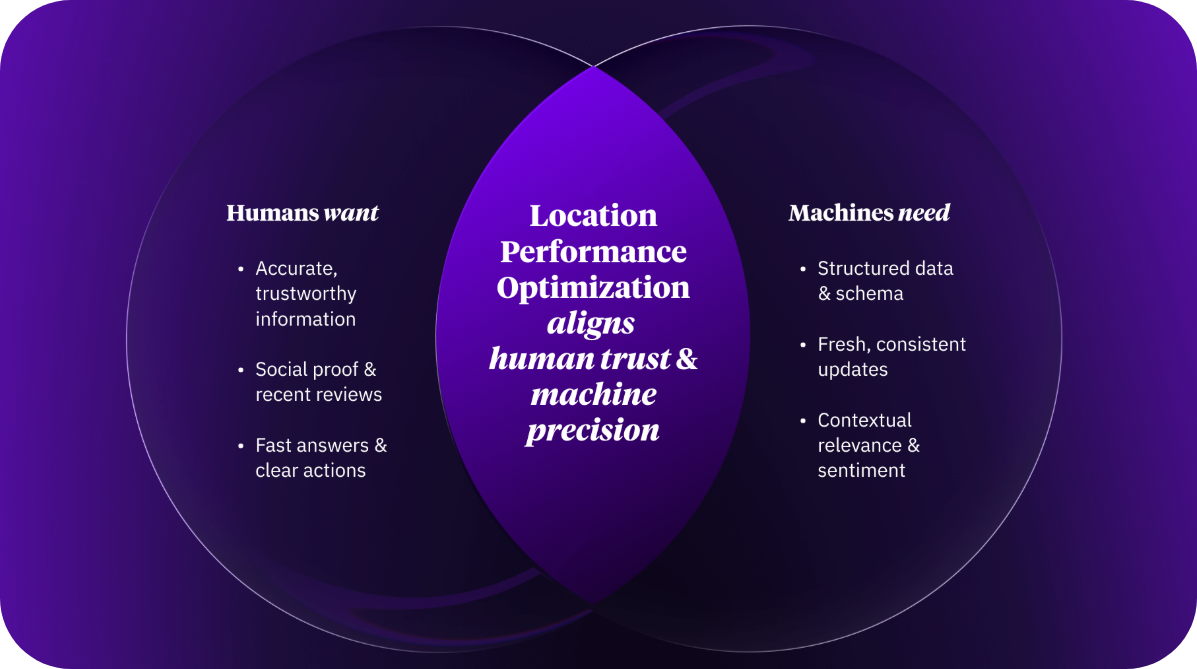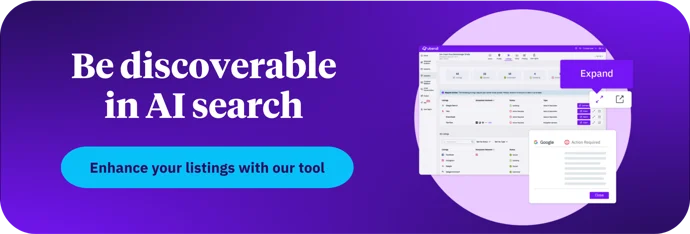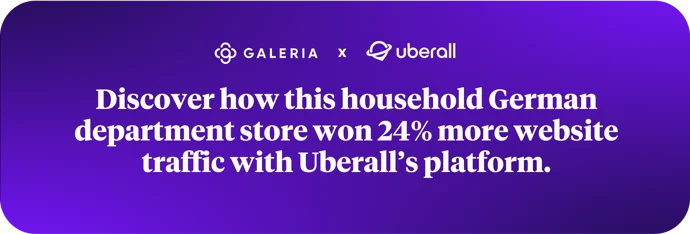
How Does the “New” Search Affect Retail Marketing Strategies?
Almost 6 in 10 consumers are now using AI tools for product and service discovery.
Does that scare you — or inspire you? Does that strengthen your current retail digital marketing strategy or undermine it?
No matter how you’re answering these questions, you’re not alone in navigating this new (and noisy) normal.
And that’s not the only thing you’re navigating: Being a retail business in a cost-of-living crisis is tough. You might be working harder to drive non-essential purchases and to get customers to visit your brick-and-mortar stores in person instead of buying online, with minimal brand interaction.
But there is good news: Experts are telling us that local SEO is thriving in the AI search era. And our team wants you to make the most of this by converting today’s opportunity into tomorrow’s financial reward.
What Is Today’s Retail Customer Journey?
When we talk about retail, we’re talking about a broad spectrum of businesses — from consumer electronics and fashion to supermarkets, home improvement, telecoms, and sports equipment. That’s not an exclusive list.
But no matter the product or specialty, one thing unites every retail business: The retail customer journey is hybrid (or omnichannel — whichever term you prefer to use).
Today’s consumers rarely walk into a store cold. Our data tells us that 91% start their buying journey with an online search, whether it’s with Google or an AI tool like ChatGPT.
Before setting foot in one of your physical stores, these consumers typically:
read reviews
visit the business’ website
click for directions
check photos/services
check social media pages
contact the store directly
Our report even reveals that 55% of consumers visit businesses within a week of that online search.
If your retail brand isn’t visible at that first moment of intent — or if consumers don’t like what they see across your listings, website, or social channels — you risk being overlooked or replaced by a competitor, whether in AI or traditional search.
Our latest report explores how multi-location retail businesses are performing across four key pillars — visibility, reputation, engagement, and conversion — so you can see exactly how you compare within your industry.
1. Visibility: Are Your Profiles Complete?
Customers can’t choose you if they can’t find you online or offline. If you want your brand to be top of mind, maximizing your visibility is an excellent (and logical) place to start.
And visibility isn’t a one-and-done task (unfortunately); it’s a living ecosystem. You’ve got to regularly update your business listings with accurate information, fresh photos, and authentic content.
If you’ve already been maintaining consistency across your listings, networks, and platforms, you’re ahead of most marketers — and ready for whichever search platform your customers choose to use.
If not, now’s the time to refocus. There’s more at stake than ever — even leading retail brands are seeing clicks and impressions fade away when their visibility isn’t properly managed.
Start by ensuring complete, verified entries across all major directories: Google Business Profile, Apple Business Connect, Bing Places, and Yelp. Each additional platform expands your reach to new audiences and increases your AI inclusion rate – or your share of voice in AI search.
If you’re questioning whether this is worth the time: A consistent cross-channel presence sends powerful trust signals to both search engines and generative platforms like ChatGPT, helping algorithms understand that your business is active, relevant, and worth recommending.
Visibility is no longer just about ranking; it’s about being recommended. And in the AI era, the businesses that show up consistently across every channel and platform will be the ones that customers — and algorithms — trust most.
Step one of any digital retail marketing strategy is to show up; step two is to show up as a trustworthy local brand.
Reputation is one of the strongest signals of trust in local search — and it’s earned when you focus on showing up as a consistent, responsive, and authentic retail business.
This in part comes down to optimizing your visibility as mentioned above, because these consistent mentions send signals of trustworthiness.
But reviews are the real center stage of your local store’s reputation. More than half of customers read reviews for local businesses before visiting them, which makes them an integral part of your strategy to win customers over – or win them back.
Managing that dialogue well — celebrating positive feedback, addressing concerns, and showing responsiveness — has a direct impact on your reputation and customer loyalty.
Across the retail sector, our reputation data tells a clear story:
Star rating: Retail performs well overall, averaging 4.16 stars, with leading retail brands reaching a perfect 5.0; the lowest reached 2.13.
Review volume: Top-performing retail brands gather more than 600,000 reviews, with standout locations earning 60+ per month — but most locations lag far behind, missing easy wins.
Response rate: Only about half of reviews get a reply, while the best performers in retail respond to all.
Sentiment: At an average score of nearly 77%, most retailers are keeping customers happy — but the gap between leaders and laggards is still wide, with the lowest scoring 35%.
For retail marketers like you, this data represents opportunity. Implementing consistent review-response workflows across all locations can quickly boost review volume, credibility, and local engagement.
AI tools can help here — ensuring reviews are requested promptly, analyzed for sentiment, and managed efficiently across hundreds or even thousands of locations.
3. Engagement: Are Your Profiles Relevant?
“Large language models don’t deliver a good local search experience.”
That’s the headline of a recent Search Engine Land article, where author Rob Tindula notes that AI-powered results are often “vague, lack images, and list places that aren’t even nearby.”
For retail marketers, that’s not a problem — it’s an opportunity.
This is your chance to deliver a richer, more relevant search experience for high-intent customers using AI tools for local discovery.
Engagement is where visibility turns into connection. It’s how you convert casual browsers into brand evangelists — across both digital and physical touchpoints.
Social media plays a big role here, especially for younger audiences. But many retailers keep their content too generic. Make every location feel local: Share in-store moments, promote seasonal events, or feature community initiatives on your local landing pages.
And don’t stop there. Regularly post on your Google Business Profile and Apple Maps Showcases about new arrivals, promotions, or store updates — always with high-quality images.
Even modest, authentic engagement can make your brand stand out, particularly when competitors rarely update their profiles.
Consistent posting doesn’t just keep customers engaged; it also sends strong freshness signals to AI platforms, showing that your business is active, reliable, and relevant.
In short, engagement means showing up where your customers already are — and giving them a reason to connect, share, and return. Every interaction, post, and event reinforces your local relevance and keeps your brand top of mind.
4. Conversion: Are Your Profiles Persuasive?
Conversion is where discovery turns into action. It’s the moment when an online search becomes an in-store visit, a call, or a sale — and every detail in the customer journey can make or break that decision.
In retail marketing, conversion starts with the basics: Make it easy for customers to find, contact, and visit your stores. That means integrating a store locator and local landing pages into your website and keeping that information fully aligned with your listings on Google Maps, Apple Maps, and other key platforms. Don’t make these actions harder than they need to be.
To drive conversions directly from search results, each Google Business Profile or Apple listing should include clear, relevant calls to action — and track these conversions, such as bookings, menu opens, or service page visits. They connect real customer intent to revenue impact.
Add UTM tags and call tracking to measure performance and refine what works.
The data from our recent report shows just how powerful small optimizations have been for our retail clients:
Clicks for directions: Retail locations averaged 710 direction clicks in the first half of 2025, while top performers exceeded 22,000. Locations with missing or incorrect details saw none — proving how crucial accurate hours and addresses are for turning local intent into store visits.
Clicks to website: On average, each location generated 485 website visits as shoppers browsed offers or product details. Top performers saw 20,000+. Retailers with fast, mobile-friendly websites and clear information consistently convert more digital explorers into buyers.
Clicks to call: Each retail location handled around 219 calls on average — often from customers checking stock or hours — while leading stores fielded over 5,400. Responsive call handling remains a major conversion driver, even in the age of AI search.
Conversion is about removing every possible barrier between online curiosity and in-store action. It’s about aligning what your customers want with what search machines need.
For retail marketers, optimizing these final steps — from consistent listings to seamless omnichannel experiences — transforms visibility, reputation, and engagement into measurable revenue, completing the Location Performance Optimization (LPO) loop.

Local Retail Queries Still Drive Action
AI may be reshaping how consumers discover brands, but what drives action remains the same — relevance, trust, and convenience still win.
For retail marketers, that means doubling down on what you can control:
showing up where customers search
keeping your profiles complete and trustworthy
engaging authentically
making it effortless for shoppers to take the next step
That’s what Location Performance Optimization (LPO) is all about — turning online visibility into real-world impact for our retail clients.
By mastering the four LPO pillars — visibility, reputation, engagement, and conversion — retail brands stay both top of mind and top of results, no matter where the customer journey begins.
In a landscape where budgets are tight and every click counts, the brands that optimize locally are the ones that grow globally.




